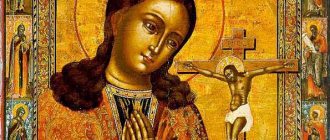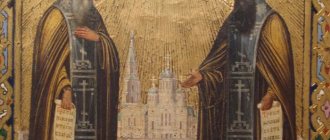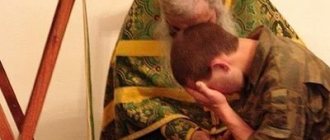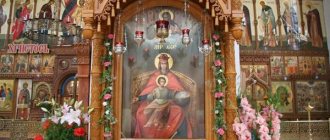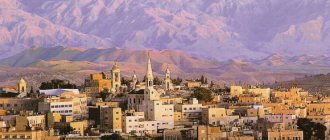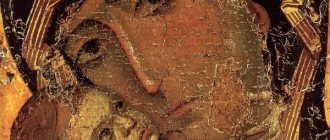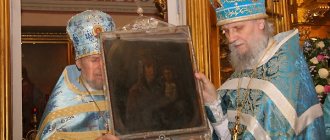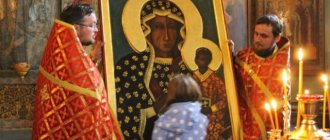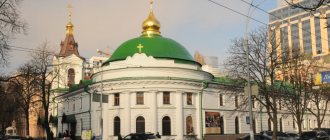The Albazin Icon of the Mother of God “The Word became Flesh” is an icon with the Image of the Mother of God and the Child Christ, considered miraculous, also called the Defender of Amur. It takes its name from the Albazin fortress, which was founded by the explorer Erofey Khabarov in 1650. Now the village of Albazino stands on the site of the fortress.
It is not known for certain where and by whom the icon was painted. Experts estimate its approximate age to be about 400 years.
Part of the title “the word became flesh” is a quote from the Gospel of John: “And the Word became flesh and dwelt among us, full of grace and truth” (John 1:14).
The type of iconography is Oranta, which means Praying. The Albazin icon depicts the womb of the Infant God. She is distinguished by a special image of the Ever-Virgin and the Baby in the Womb.
Mystery of origin
In fact, there is no information about when the image was painted. It is unknown who its author was. Experts say that the image is more than 400 years old.
And this is his story. From time immemorial there have been attacks on Rus'. And the middle of the 17th century was no exception. The Chinese could not calm down. They really wanted to conquer the Albazin fortress. It is now impossible to count how many attacks and provocations were committed by the invaders.
In the end, the Chinese managed to accomplish their plan. The fortress was burned. But time passes, the year 1665 comes. It was then that Albazin was restored. Ardent faith in the intercession of the Mother of God is all that helps people in their confrontation with the Chinese.
A very difficult time has come. Soldiers and civilians needed strengthening of spirit. It was then that an old man named Ermogen came to Albazin. He was the founder of the Ust-Kirensky Monastery. The elder brings icons with him. Among them is the icon of the Albazin Mother of God.
In 1671, Ermogen founded a monastery near Albazin. He was one of the first on the Amur. The elder lived in the monastery until 1680, where the icon of the Albazin Mother of God, or “The Word became Flesh” (its second name), was also located there.
But the Chinese are not calming down. The raids continue. The elder leaves the monastery. And the icon is taken to Sretensk in order to preserve it from encroachment by the Chinese.
The meaning of the Feast of the Nativity of the Blessed Virgin Mary
Saint Andrew of Crete also writes about this holiday in his word, calling it “the beginning of the holidays.” The reason for this is that the Mother of God opened with Her birth a new era, supported by the hope for the salvation of the human race. After the fall of our ancestors Adam and Eve, humanity was under the yoke of an oath. People could no longer go to heaven, which was the purpose of man's appearance on earth.
We advise you to study Prayers to Righteous John the Russian
For several centuries, people had to die and go to hell, which was punishment for sins. But the Lord, who did not want the death of sinners, decided to descend and redeem humanity with His death on the cross. But for this He had to appear on earth as a simple man. It was planned this way so that He would not stand out among people. Therefore He had to be born of a woman, although without the participation of the male sex.
For this purpose, the Purest and Holy Wife on earth was chosen. She became the maiden Mary. She was a relative of Joseph, who was from the family of David. Thus the prophecy came true that Christ would be from the line of David. Joseph took Her to him after She finished Her many years in the temple. She was sent to the temple at the age of three according to the vow of Her parents, who viewed Her birth as a gift from Above. Therefore, they decided to dedicate the Daughter to God.
About the parents of the Ever-Virgin Mary
Saints Joachim and Anna were childless. Since in Israel many children were considered a special blessing of God, spouses who did not have children were considered sinners, thus bearing punishment
Joachim and Anna suffered constant reproach from their fellow tribesmen. When Joachim came to the temple with the goal of making a sacrifice to God, the priests rejected his calf, saying that he was too sinful to do this. The upset husband went into the desert and brought a fervent prayer to the Lord.
God heard His faithful servant and sent him an Angel, who consoled him and told him to go home. At this time, his wife saw a nest near her porch in which the chicks had hatched. The bird parents happily looked after them. Anna burst into tears, envying their happiness. “Everyone has children except us,” she thought. When an Angel appeared to her and said that God had heard her prayers and they would have a Daughter, Anna did not believe it. After all, she and her husband have already crossed the threshold of old age, and physiologically they cannot have children. But the Angel assured her of the faithfulness of the promise.
After this, nine months later, the elderly couple gave birth to a long-awaited child, who was named Maria, which means “Lady.” She truly became the Mistress for the entire human race, the Queen of Heaven, because she was honored to carry within herself the Creator of the world, who created everything visible and invisible.
This honorable fate went to Her for a reason: Mary never sinned in her life, not even in her thoughts! For this she was nicknamed “The Most Pure One.” The entire Orthodox and Catholic world reveres the Most Holy Theotokos and this holiday as Her birthday, because She became the Mother of the Savior, who redeemed the human race.
Features of worship
The troparion and kontakion of the holiday glorify the Most Holy Theotokos and Her holy parents. They also say that Joachim and Anna got rid of the reproach of childlessness on this day, and Adam and Eve got rid of the ancient curse.
On this holiday an all-night vigil is served. Proverbs at Great Vespers remember Jacob's ladder, the closed gates that the prophet Ezekiel saw, and the house that Wisdom built for herself. These prophecies predict the birth of God's Chosen Maiden.
After the polyeleos at Matins, the magnification of the holiday is sung, which glorifies the Most Holy Theotokos and Her holy parents. Then “From my youth” is sung. The canons of the holiday were written by: Saint John of Damascus and Saint Andrew of Crete.
Katavasia is sung on the feast of the Exaltation of the Holy Cross: “Moses drew the cross.” “The Most Honest” is not sung, instead the chants of the holiday.
At the Liturgy of St. John Chrysostom, the Prokeimenon of the Theotokos, the Apostle and the Gospel of the Feast are sung.
The chants for the holiday wrote:
- Saint Andrew of Crete;
- Saint John of Damascus;
- Saint Stephen of Svyatogradets;
- Patriarchs of Constantinople (Anatoly, Sergius, Germanus), etc.
This holiday is one of the most beloved among the people.
The Nativity of the Blessed Virgin Mary - a story from the Law of God
XX century
Religious processions are performed with the icon of the Albazin Mother of God. Prayers are held before it. Since the beginning of the 20th century, annual religious processions across the Far East begin. In those places where it was impossible to walk with the icon, it was transported by ship or train.
Time passes, a revolution is coming. Everyone knows about its consequences for Orthodoxy. Blagoveshchensk was not spared the consequences either. The cathedral was blown up in 1924.
They managed to hide the icon of the Albazin Mother of God. Now she has found a place in the Elias Chapel.
The godless government was not going to come to its senses. Temples were closed and destroyed, and church utensils were destroyed. The icon was lucky; it was taken to the Amur Regional Museum of Local Lore. This happened in 1938.
Icon in the house
Icons should be placed in a place separate from other items. Icons look extremely inappropriate in bookcases where secular books are stored, on shelves next to cosmetics, photographs of loved ones, toys, figurines, or simply as some kind of interior decoration. You cannot place posters of pop performers, political figures, athletes and other idols of the current century next to icons. There should not be any artistic paintings among the icons, even those painted on biblical subjects. A painting, even if it has a religious content, such as “The Appearance of Christ to the People” by Alexander Ivanov or “The Sistine Madonna” by Raphael, is not a canonical icon. Sometimes you see photographs of priests, elders, monks, and people of righteous life among the icons. Canonically, this is unacceptable, because photography is an image that captures a specific moment in a person’s earthly life, even if later glorified by the church as a saint. And the icon tells us about him, precisely as a saint, in his glorified, transfigured state. Of course, such photographs can be in the home of an Orthodox Christian, but they must be placed separately from the icons.
We advise you to study the Icon of St. Martha
There is a misconception that spouses should not hang icons in the bedroom, and if there are icons, they should be covered with a curtain at night. It's a delusion. Firstly, no curtain can hide from God. Secondly, marital intimacy in marriage is not a sin. Therefore, you can safely place icons in the bedroom. Moreover, many of our compatriots do not always have the opportunity to place icons in a separate room designed for this. Of course, the icon should be in the dining room or, if the family is dining in the kitchen, then there, so that you can pray before eating and thank the Lord after the meal. Icons can be in every room, there is nothing bad or reprehensible in this. But it is naive to believe that the more icons in the house, the more pious the life of an Orthodox Christian. Quite often, such collecting becomes ordinary collecting, where there is no talk about the prayerful purpose of the icon, and can have a completely opposite effect on a person’s spiritual life. The main thing is that prayer be offered in front of the icons.
It is also a mistake to believe that the icon is a kind of accumulator of God’s grace, which can be drawn from if necessary. Grace acts not from the icon, but through the icon, and is sent by the Lord to those who believe in Him. You can endlessly venerate a sacred image, without having faith in the real power of God’s life-giving grace, and not get anything from it. Or you can venerate the miraculous icon once with deep faith and hope in the Lord’s help, and receive healing from physical and mental illnesses. It is also necessary to remember that the icon is not some kind of amulet that guarantees the absence of quarrels and problems in the family, as well as some kind of invisible protection from evil spirits and bad people. It is regrettable to see icons in the homes of Orthodox Christians hanging opposite the front door with a clear motivation: “This is to protect them from bad people and from the evil eye.” An icon is not and cannot be such a talisman. In general, amulets are attributes of pagan and magical cults. There should be neither paganism nor magic in the life of an Orthodox Christian. But over the entrance, according to tradition, it is customary to hang an icon of the Intercession of the Most Holy Theotokos. Although it could be any other icon or cross.
90s
The era of godlessness has passed. For almost 70 years people lived hiding their faith. And others renounced her out of fear.
The “dashing 90s” have arrived. The time of banditry, tyranny and the opening of churches. Believers began to receive their parishes back. And the remaining shrines accordingly.
The Icon of the Albazin Mother of God was returned to the Russian Orthodox Church in 1991. From that time to this day, it has been located in the Annunciation Cathedral, restored in the distant 90s.
Icon of the Mother of God of Tenderness of Lokot
From April 1 to April 8, the Lokot Icon of the Mother of God “Tenderness” will be in the Smolensk Church.
From February to June, in the churches of the Oryol Metropolis, with the blessing of His Eminence Metropolitan Anthony of Oryol and Bolkhov, there will be a miraculous icon of the Mother of God “Tenderness” from the village of Lokot. In 1999, the icon began to stream myrrh. This is a two-sided miraculous myrrh-streaming image.
The history of the appearance of the icon.
The shrine appeared in one pious family in the village of Lokot, the former estate of Grand Duke Mikhail Romanov, brother of Tsar Nicholas II.
A resident of the village of Lokot, Bryansk region, Natalya Shishkova, as usual, went to the local department store and saw calendars with the image of the Mother of God lying neglected on the store counter.
She made a remark to the saleswoman that even though the calendars are not church calendars, since there is an image of the face of the Mother of God, it is unworthy to store it in this form, but it is necessary to store it in a proper way.
To which the saleswoman said that these calendars were expired, and anyway no one would buy them and they would have to be thrown away.
Natalya went home, and on the way the thought occurred to her that she had denounced the saleswoman, but she herself just needed to buy this calendar. She went back and bought the last two calendars of the Mother of God with the Tenderness icon. I cut off the numbers and hung them on the wall at home and at work using regular push pins.
As in the case of the Iveron Montreal Icon of the Blessed Virgin Mary, she at first decided that someone had spilled cologne or perfume in the house, but when she began to look for the source of the aroma, she discovered that a large, greasy, fragrant stain had formed on the face of the Mother of God.
She invited a priest, who, having looked, noticed that now this often happens, when not only in churches, but also in the homes of lay people, images begin to stream myrrh, that you don’t need to pay attention to it, you look - it streams myrrh and will pass.
But the flow of myrrh and the fragrance did not stop; moreover, the flow of myrrh increased over time in such quantity that the myrrh flowed from the image onto the wall.
Seeing this, the priest said that this must be approached with caution, in case this miracle is not from God: “Let’s pray, and if during Great Lent this miracle stops, then this miracle is not God’s.” But on Easter, in their house, all the icons that they have, and there are quite a lot of them, were filled with myrrh. It became clear that this was truly a miracle and they decided to place this image in an icon case, in a frame
It became clear that this was truly a miracle and they decided to place this image in an icon case.
They took it off the wall and, to their amazement, discovered this: you know that myrrh is an oily substance that saturates the paper right through, and since the entire image was covered with myrrh, it would seem that the calendar should also soak up this world through and through.
But when they took it off the wall, they saw that on the reverse side only the face of the Mother of God was saturated with the world! The rest of the surface of the calendar remained as white and dry as before.
The study of miracles associated with the icon of “Tenderness” is carried out by a special expert group on miraculous phenomena in the Russian Orthodox Church under the leadership of Professor P.V. Florensky. Over the past 19 years, there have been many cases of healing and grace-filled help in everyday needs of people who came to her to worship.
Schedule of stay of the Lokot Icon of the Mother of God
- April 1 - April 8 - Smolensk Church;
- April 8 - April 15 - Epiphany Church;
- April 15 - April 19 - Baptist Church;
- April 19 - April 24 - Alexander Nevsky Church (900 block);
- April 24 - April 29 - St. Nicholas Church;
- April 29 - May 3 - Vvedensky Convent;
- May 3 - May 8 - Trinity Church;
- May 8 - May 13 - Mtsensk;
- May 13 - May 20 - Bolkhov.
Materials from the Information and Analytical Department of the Oryol Metropolis were used
Interesting Facts
The first mention of the miraculous properties of the icon dates back to 1900. When there was a Russian-Chinese conflict, our opponents fired at Blagoveshchensk across the Amur. The Cathedral with the icon of the Albazin Mother of God was in the line of fire. Remarkably, he was not injured during the shelling. And the city remained practically untouched.
As the attacking Chinese later recalled, a very beautiful woman appeared in front of them several times. She was holding a child in her arms. Because of their feelings of pity for their mother, the Chinese were unable to conduct aimed fire.
And the second miracle happened in our time. It was 2013. A terrible flood began in the Far East. And what were people supposed to do? Just pray, trusting in the mercy of God. And Bishop Lucian made a decision: to fly around the most affected places with the icon “The Word became Flesh.” Two days passed after such a “heavenly religious procession”. And the water stopped coming. This fact is officially registered.
What does it help with?
First of all, the icon is considered the protector of the Orthodox of the Amur region. Local believers treat her with the greatest reverence. Traditions have preserved many testimonies telling about the miraculous salvation of villages from enemies and epidemics.
Clergymen pass on from generation to generation stories about how in 1895
A terrible pestilence came to the city of Blagoveshchensk. At the height of the epidemic, the clergy walked around the entire city in a religious procession with the Albazin Icon, sprinkling their path with holy water. After this, the pestilence stopped.
Nowadays, as in former times, people come to the face of the Mother of God asking for the healing of various diseases. Cases have been repeatedly recorded in which, thanks to fervent prayer, seriously ill people, whom scientific medicine had abandoned, recovered.
Modern believers turn to the icon with prayer for the salvation of their souls. They ask for intercession for themselves, their family and friends from illnesses, unclean thoughts, and dashing people.
Remembering the miraculous protection of the image of settlements when attacked by enemies, Orthodox Christians pray for the health and well-being of recruits drafted into the army, for those who are fighting in hot spots. Mothers ask the Mother of God for protection for their sons, wives for husbands, children for fathers. About their safe return home.
Most often, those who for some reason do not have children turn to the image with a request to conceive a child. Sometimes these are characteristic diseases, but it also happens that the parents are healthy, but they do not have a child. This means that the Lord is punishing them for serious sins. Then all that remains is to sincerely repent and fervently pray for forgiveness and intercession, asking the Most Holy Theotokos for protection before the Savior and the Lord God.
What are they praying for? Prayer text
In front of the icon they pray for help, asking for a safe release from the burden. The prayer to the icon of the Albazin Mother of God is presented below:
Virgin Mary, Most Immaculate Mother of Christ our God, Intercessor of the Christian race! Standing before Thy miraculous icon, our fathers pray to Thee to show Thy protection and intercession to the Amur country. In the same way, we now pray to Thee: preserve our city and this country from the presence of foreigners and save from internecine warfare. Grant the world peace, the land of fruits in abundance; preserve our shepherds in the sanctuary, the toiling ones in the holy temples: protect the builders and their benefactors with your almighty protection. Confirm our brothers in orthodoxy and unanimity: bring to their senses those who have gone astray and have departed from the Orthodox faith and unite them to the Holy Church of Your Son. Be the protection, consolation and refuge from all evils, misfortunes and circumstances to all who flock to your miraculous icon, for you are healing for the sick, consolation for the afflicted, correction and admonition for the lost. Accept our prayers and lift them up to the Throne of the Most High, for by your intercession we are observed and by your protection in the fall, let us glorify the Father and the Son and the Holy Spirit, now and ever and unto ages of ages. ́v. Amen.
LiveInternetLiveInternet
Tuesday, September 02, 2014 20:59 + to quote book
For the Amur region and the entire Far East, a great shrine is the miraculous Albazin Icon of the Mother of God, called “The Word became Flesh.” The plot and title “The Word became flesh” became a reflection of the Gospel narrative from John: “In the beginning was the Word, and the Word was with God, and the Word was God... And the Word became flesh and dwelt among us, full of grace and truth” (John 1; 1, 14). The Most Holy Theotokos is depicted waist-length, straight. Her hands support the Infant of God standing in front of Her at full height. His right hand (right hand) is pressed to his chest. Shuitsa (left hand) is lowered down. On both sides of the Mother of God's face are two six-winged Seraphim. The history of the miraculous icon is inextricably linked with the Russian exploration of the vast Far Eastern region. Unfortunately, the events associated with the initial appearance of the holy image have been lost in history. But we can reliably assert the deep antiquity of the veneration of the Albazin Icon of the Mother of God. It was considered miraculous long before it was transferred to the Amur region from Siberia. The most revered Orthodox shrine in the Far East owes its name to its twenty-year stay in the Albazinsky fort, as well as in the Spassky Monastery located not far from it. XVII century The first mention of Albazin dates back to 1650, and is associated with the name of Erofei Khabarov. The detachment of explorers he led occupied the town of the Daurian prince Albaza on the upper Amur, whose name remained in the name of the Russian fort. Having set off on a campaign down the Amur, Khabarov left 50 Cossacks in Albazin to guard the fort and collect yasak. Meanwhile, on the other side of the Amur, the wild tribes of the Manchus were acting aggressively. After conquering China, they established their Qing dynasty there. The first Qing emperor Shun-chih, in 1651, sent a thousand-strong army to Albazin with the aim of expelling the Russian neighbors who had settled there. In 1658, the Manchus managed to destroy Albazin, as well as several other Russian settlements and towns. But this did not stop the explorers. In 1665, a group of fugitive Cossacks led by Nikifor of Chernigov came to the Amur, sentenced to death for the murder of the Ilimsk governor. On the site of the Albazin settlement they built a new fort, which became the center of the free Cossack republic. Having settled in, the Cossacks took active steps to earn the Emperor’s forgiveness. To achieve this goal, they quickly forced the local population into submission and began to take yasak from them. The population of Albazin gradually increased. Cossacks and industrial people from the remnants of various expeditions, fugitive peasants from Siberia and the so-called “walking people” flocked here. Russian settlements and winter huts began to appear around the fort. In 1672, after receiving the yasak collected on the Amur and a petition letter from the Albazinians, a decree was issued in Moscow, according to which Chernigovsky was subject to pardon and was appointed tsar's clerk in Albazin. Hieromonk Hermogenes hands over the miraculous icon to the Albazin Cossacks. Hieromonk Hermogenes arrived on the Amur with Chernigovsky’s detachment. Before his resettlement, the elder was known as a prominent figure in the Orthodox education of the lands of the Baikal region and the organizer of the Ust-Kirensky Holy Trinity Monastery, which he founded in 1663. Out of firm faith in the Providence of God, which arranges everything for the good, Elder Hermogenes complacently submitted to his difficult fate and even more diligently devoted himself to the prayerful feats of monastic life. In those difficult years of development of the eastern regions, it was the Orthodox clergy who were the founders and bearers of the spiritual strength and spiritual culture of the pioneers. Russian settlers who reached the eastern outskirts of Rus' were the first Christians there. The general rule of the pioneers was: “where there is a winter hut, there is a cross or subsequently a chapel; where there is a fortress, there is a church and a cannon; where there is a city, there is a voivodeship office, guns and a monastery, in addition to the church.” Near the Albazinsky fort, the Cossacks erected a chapel in honor of St. Nicholas the Wonderworker. On the territory of the fort there was another chapel in honor of the Resurrection of the Lord. Later, the Resurrection Church with chapels in honor of the Vladimir Icon of the Mother of God and Archangel Michael was erected here. In 1671, four kilometers above Albazin, Abbot Hermogenes founded a monastery in the name of the Most Merciful Savior. On the other side of Albazin, one mile down the Amur, Elder Hermogenes and his brethren built another hermitage with a church and founded an arable farm. In the monastery and its courtyard rebuilt by the elder Hermogenes, only four monks labored, who earned their living by grinding grain for the Albazinians at two monastery mills, and also engaged in blacksmithing. In this small monastery there was the holy icon “The Word Flesh Wast,” brought by Hermogenes from the Baikal region. According to researchers, it could have been written with the participation of the spiritual authorities of Siberia for church services. In the first half of the 17th century, several icon painters were sent to Tobolsk from the cities of Ustyug the Great, Sol Vychegda and other cities of the northern outskirts of Russia. This event strengthened the icon painting school in Siberia. From now on, they painted icons here for the entire vast eastern region from the Urals to Kamchatka. It is also possible that the Albazin shrine was brought by one of these masters, since everything indicates that its writing style belongs to the Northern school of icon painting. According to some sources, two such icons were painted. One of them is in the form of a panagia, called “Bearing Grace.” Presumably the name of Nicodemus the schema-monk who wrote them in 1492 is also reported. According to the Treaty of Nerchinsk, concluded in 1689 after many years of confrontation between the Manchus and Russians, the Albazinsky fort was subject to destruction, and the Russians were forced to leave the Amur region. Even earlier, the miraculous icon was taken away from here. In 1685, when, under pressure from the Manchus, the Cossacks left the fortress for the first time, Elder Hermogenes also left with them. He transferred the holy image of the Mother of God “The Word Flesh Become” to the city of Sretensk, and he himself soon went to the Holy Trinity Kirensky Monastery, which he had previously built, where he soon died. It was in Sretensk that the shrine he brought received the name “icon of the Albazin Mother of God” and became a symbol of Russian domination in the region. 19th century Metropolitan Innocent and Archbishop Benjamin
The Amur region again became Russian territory only in the second half of the 19th century did the Russians return to the Amur. In 1858, the episcopal see of the vast Far Eastern diocese was moved to the city of Blagoveshchensk, the center of the newly formed Amur region. In 1868, on the recommendation of the High Hierarch of the Amur Bishop Innocent, Bishop Veniamin (Blagonravov) was appointed his successor. The new bishop from Sretensk arrived at the place of new service together with the Albazin Icon of the Mother of God. The commemorative inscription on the silver robe stated that “This Albazin Icon of the Mother of God was brought from Sretensk to Blagoveshchensk by His Eminence Veniamin, Bishop of Kamchatka, Kuril and Aleutian in June 1868 upon his first entry into his diocesan city.” Upon arrival in Blagoveshchensk, the shrine was placed in the Cathedral in honor of the Annunciation of the Mother of God. Thanks to the diligence of the bishop, another shrine from the legendary fortress returned to the revived Albazin - the image of the Savior Not Made by Hands, also brought to the Amur, and later carried to Sretensk by Elder Hermogenes. The Right Reverend Benjamin proved himself to be a worthy successor and continuer of the hierarchical endeavors of St. Innocent. With the increase in the number of churches, lists of the Albazin icon appeared for most of them. One list was presented to Tsarevich Nikolai Alexandrovich, the future Emperor Nicholas II, during his visit to Blagoveshchensk on June 4, 1891. The veneration of the miraculous icon by Orthodox Christians in the Amur region grew year by year and soon culminated in the fact that in the fall of 1895, by decree of the Holy Synod, a general diocesan holiday was established in honor of the holy Albazin Icon of the Mother of God, which began to be celebrated annually on March 9 (March 22 - according to the new style). On this day, festive liturgies and prayer services were served in the Cathedral and in other churches of the diocese, as they invariably serve now. Subsequently, permission was received from the Holy Synod to move the shrine among the parishes of the diocese so that residents of remote villages could pray at the miraculous image. 20th century The miraculous icon in the cathedral The fertile spiritual life of the Amur region changed dramatically after 1917. On the night of the Dormition of the Blessed Virgin Mary from August 28 to 29, 1923, Archbishop Evgeniy (Zernov) was arrested. Thus, the Annunciation diocese, deprived of its canonical bishop, ceased to exist as a full-fledged component of the single body of the Russian Orthodox Church. Although bishops were subsequently sent here, no one reached their destination - they were arrested even before arriving in Blagoveshchensk. In 1924, the Annunciation Cathedral burned down for unknown reasons. The Albazin Icon of the Mother of God, located there, miraculously survived and was transferred to the Ilyinskaya Chapel. In this 1938, the Prophet Elijah Church was closed. All of her property, including 73 church items, was transferred to the museum. From that moment on, the miraculous shrine of the Amur region was kept in closed storage facilities of the Amur Regional Museum of Local Lore. Only in 1991 was the icon returned to the Russian Orthodox Church and transferred to the Annunciation Church in a majestic religious procession. Eyewitnesses of those events report many unusual moments that occurred. So, on a frosty November day, after the icon was transferred to the temple, having walked a considerable distance through the streets of the city, the flowers that adorned the face of the Mother of God on the holy icon remained alive and were preserved for a long time. When the icon was brought into the temple, after the frost, droplets of moisture naturally appeared on it, but they flowed symmetrically from the corners of the eyes of the Mother of God. This was perceived by the participants of the procession as a miraculous sign of the Queen of Heaven’s favor for such an important event in the spiritual life of the Amur region - the third coming to the Orthodox children of the great Shrine of the Amur region according to the faith and prayers of them and their glorious ancestors. In 1997, the tradition of pilgrimage with the icon was resumed. Over the next 15 years, she visited Moscow, Nikolaevsk-on-Amur, Khabarovsk, Vladivostok, Yuzhno-Sakhalinsk, Kholmsk, Chita and Magadan, and traveled around the Birobidzhan diocese. In 2002, the icon was sent for restoration to Sofrino. Specialists from the Moscow region restored the worn paint layer, removed scratches and cracks, and applied a new layer of varnish. In 2003, the Abaza shrine was moved to the new Blagoveshchensk Cathedral, on Relochny, where it remains today. Every Friday at 7.00 in the Annunciation Cathedral, a prayer service is held in front of the Albazin Icon of the Mother of God with the reading of an akathist, the rite of blessing of water and blessing of oil. TROPARION TO THE ALBAZIN ICON OF THE MOTHER OF GOD Tone 3 Our all-merciful intercessor, / Mother of the incarnate God of the Word, / revealed Her miraculous image on the Amur region of the earth, / from it you poured out Grace abundantly, / giving healing to mental and physical ailments. / Oh, All-Blessed Mother of God, / Helper of non-idle wives in childbirth, / and chosen victorious Voivode, / Strong Shield from the invasion of foreigners, / Strengthen Orthodoxy at the ends of the Russian land, // and give great mercy to our souls.
| Categories: | Orthodoxy/Prayers
Orthodoxy/Meaning of Life History Interesting video |
Tags:
Miraculous Albazin Icon of the Mother of God
Cited 5 times Liked by: 2 users
Like share
0
Like
- 2
I liked the post - Quoted
- 0
Saved
- Add to quote book
- 0
Save to links
Liked2
0
Miracles from the icon
The Diocese of Annunciation has collected many stories about miracles performed before the image.
Let's start with the recent past. This happened in 2015. A woman named Inessa could have been fired. For her, this was tantamount to death. She was on the verge of despair. She went to the Annunciation Cathedral to see the icon of the Albazin Mother of God. How the woman cried and begged for help, only she knows.
At this time, a woman approached her. She warmly hugged and consoled. She said that the Mother of God would not leave Inessa. And so it happened. Help was immediate. For Inessa, this was a real miracle and salvation.
Another resident of Blagoveshchensk testifies that after a prayer service in front of the miraculous icon, her son found a good job in his specialty.
And the most touching story happened at the end of 1990. A man named Yuri's mother fell ill. Oncology is a death sentence for an elderly woman. Yuri asked the servant of the temple, in which the Albazin icon was then located, to pour him some oil from her lamp. In exchange I gave him a bottle of excellent oil.
He sent the resulting treasure to his mother in another city. He told her to apply it regularly and add it to her food. Yuri did not specify where this oil came from.
The mother followed her son's recommendations. She began to improve and the pain went away. And most importantly, doctors have recorded a positive trend. Yuri's mother lived another 13 years after that. She died from a completely different disease.
Meaning
The first title of the Albazin icon, “The Word became flesh,” is a quotation from the Gospel of John: “And the Word became flesh and dwelt among us, full of grace and truth” (John 1:14).
“Word” is one of the names of God the Son, Messiah, Christ. The image, historically associated with the birth of the Amur region as a Russian land, testifies to the most important event in the history of mankind - the Birth of the Creator and Savior of the World.
The Infant Jesus in the icon holds a scroll in his left hand - another symbol of the Word. The right one blesses the people looking at Him, for whose sake He “made Himself of no reputation, taking the form of a servant, becoming in the likeness of men, and becoming in appearance like a man” (Phil. 2:7).
The Albazin icon is, first of all, about the Incarnation. And also about the fact that the feat of the Mother of God elevated Her above the cherubim and seraphim, and that She is the Intercessor of people, spreading Her Motherly Cover over them.

